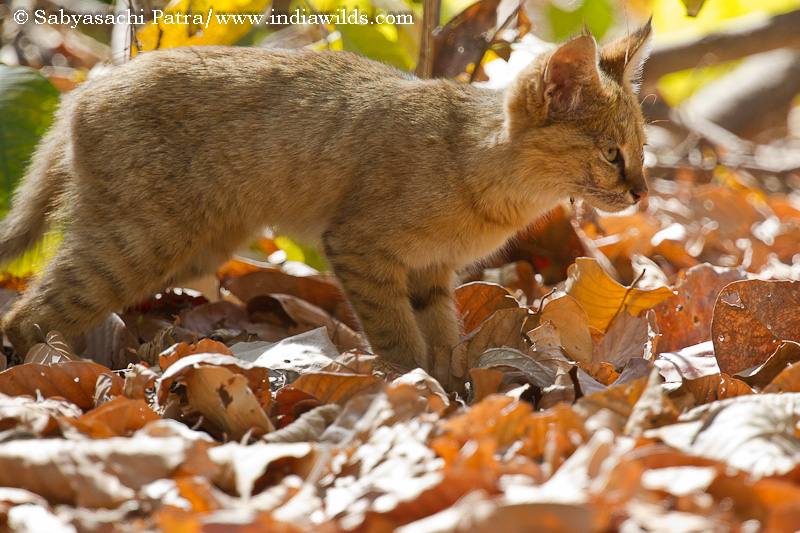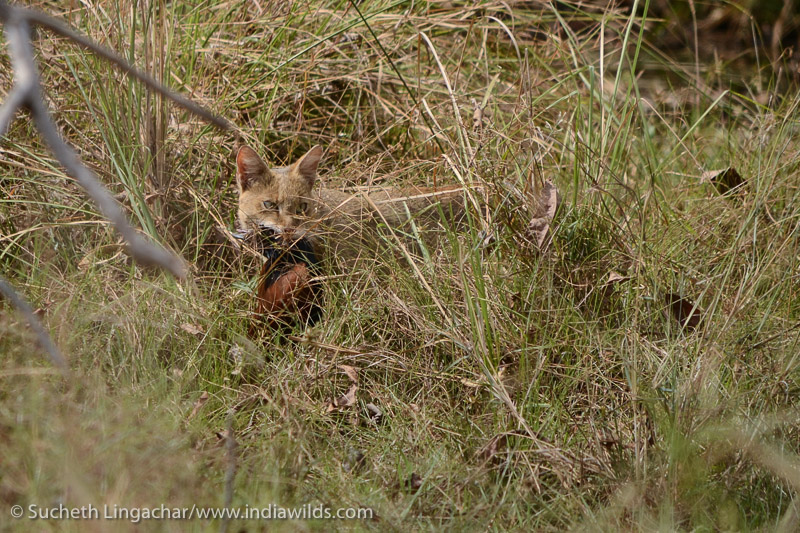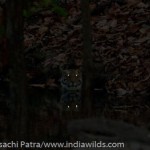Species in Focus – Wild India: Jungle Cat
Jungle cat is found in Egypt, western Asia, Indian subcontinent, Burma, China Thailand, Vietnam and Cambodia. It was first classified according to modern scientific nomenclature in the Caspian area and hence given the name Felis chaus. According to IUCN classification the status of Jungle Cat is ‘Least Concern’ and the population trend is decreasing.
Classification of Jungle Cat:
Distribution of Jungle Cat in India:
Jungle cat is widely distributed in India in open forests and scrub (M. Krishnan in India’s Wildlife in 1959-70, pub BNHS). It is found practically all over the Peninsula from the Himalayas to Cape Comorin. It is common inhabitant of most jungles (F. W. Champion, Tripwire for a Tiger: page 87), commoner in the drier parts of the country keeping more to grassland and scrub-jungle and the reedy banks of the rivers. (The Wild Animals of the Indian Empire, page 118 by S. H. Prater). It is very adaptable and occurs in habitats ranging from the vicinity of human dwellings to the densest forest (Indian Wildlife: J. C. Daniel, page 80,81).
Dunbar Brander, writing about a decade earlier than Prater,echoes similar views. Out of a number of wild-cats found in the Province, by far the most common is Felis chaus, the Jungle Cat. This animal may be found anywhere in the heart of a dense forest or in a grass patch in the open plains. (Wild Animals in Central India, Dunbar Brander, page 273)
With its long legs and comparatively short tail the Jungle Cat has a very distinctive appearance. (The Wild Animals of the Indian Empire, page 118 by S. H. Prater).
The jungle cat has morphological affinities (relatively short tail, long legs, big pointed ears) to African cats, such as serval (Leptailurusserval) and caracal (Caracal caracal), which may indicate a preference for open habitats (as opposed to closed canopy forests) (Mukherjee, Shomita Et al. (Ecology Driving Genetic Variation: A Comparative Phylogeography of Jungle Cat)
Size and Appearance:
Size:
There is a wide variation in size and appearance of Jungle Cats in India. It varies greatly both in size and appearance. I have weighed mature animals which scaled 9 lb. and others have been as much as 20 lb.(Wild Animals in Central India, Dunbar Brander, pg 273). According to J. C. Daniel In size they range up to 2 feet (75 cm) in body length with a tail half the length. The maximum weight recorded is 19.8 lb (9kg). (Indian Wildlife: J. C. Daniel, page 80,81). According to Champion “the Common jungle cat is quite a large animal, a little smaller than the average jackal and weighing up to as much as twenty pounds. It is therefore considerably larger than the ordinary domestic cat, with which it undoubtedly sometimes interbreeds”. (Tripwire for a Tiger: Selected Works of F. W Champion, page 88)
Colour of Jungle Cat:
According to Dunbar Brander the colour may be sandy grey or tawny red; some specimens are without markings except on the tail; in others the limbs may have transverse markings and the body may be marked vertically with rows of spots or wavy lines.(Wild Animals in Central India, Dunbar Brander, pg 273)
The colour of the fur varies from sandy grey to yellowish grey. The tail is ringed with black towards the end and has a black tip. The paws are pale yellowish; black or sooty brown underneath. The ears are reddish, ending in a small pencil of black hairs. The underside of the body is paler with vestiges of stripes on the underside and flanks. (The Wild Animals of the Indian Empire, page 118 by S. H. Prater). In 1930 Champion wrote “in adults there are, in most cases, no markings on the body or limbs, but the tail, which is normally rather short, is nearly always ringed with black near the end and terminates with a black tip”. (Tripwire for a Tiger: Selected Works of F. W. Champion, page 88)
There is a distinct spinal crest of hairs and a small pencil or tuft of hairs on the ears. The general body-colour is gray to tawny to deep brown. Ear tips may be black. The two stripes on the foreleg are distinctive. Three races have been described from India. (Indian Wildlife: J. C. Daniel, page 80,81)
Shri M. Krishnan feels that there is a difference in colouration of jungle cats in Tadoba National Park and has written that there seems to be a greater admixture of brick red in the grey especially in Tadoba National Park (India’s Wildlife in 1959-70, pub BNHS, page 66).
Krishnan further observed that there is a dark line running down from the inner lower corner of each eye down to the nose (on either side). In sub-adult, there were dark bars on the inner aspects of the upper half of the forelimbs and on the abdomen. (India’s Wildlife in 1959-70, pub BNHS, page 66)
These variations in colour, size and appearance can be attributed to the genetic variation in the jungle cats in India. Jungle cats revealed high genetic variation, relatively low population structure and demographic expansion around the mid-Pleistocene.(Mukherjee, Shomita Et al., Ecology Driving Genetic Variation: A Comparative Phylogeography of Jungle Cat)
Writing about the season when you have the most chance of sighting a Jungle Cat, George Schaller writes from his research experience in Kanha although fairly common in the park, they were infrequently seen except during the cool season, when they congregated on the meadow apparently while mating. (Deer & the Tiger: A study of wildlife in India, George B. Schaller, pg 311)
Litter:
It breeds during the early months of the year. Three to four kittens form a litter and the coats of these young ones are fairly spotted. (Indian Wildlife: J. C. Daniel, page 80,81)
Food of Jungle Cat:
The Jungle Cat is a stalk and ambush predator. The Jungle cat is often on the look out for rodents, gerbils, insects and also feeds on eggs of birds, especially ground nesting birds, chicks and is ever ready to pounce upon birds feeding on the ground, drinking water or when perched on low branches. In Keoladeo Ghana I observed it being flushed out from bush from its hidden position near water and it made its annoyance known to the feral cattle with a sound resembling a small roar. According to Dunbar Brander its chief food consists of birds and small mammals. It is especially destructive to game birds, most of which it kills and I have even known it to kill peafowl (Wild Animals in Central India, pg 273).
Like Dunbar Brander, Prater too says that Jungle Cat preys on small mammals and birds. It preys on small mammals, birds and, when near villages, on poultry, making bold to seize its prey even in the presence of its owners. Very swift and exceedingly strong for its size, it is quite capable of brining down larger game. Crump, writing of these cats in Kumaon says that it was not at all uncommon to find quills of porcupines which they had killed or attempted to kill embedded in their paws. (The Wild Animals of the Indian Empire, page 118 by S. H. Prater). Champion too writes that Jungle Cat feeds on birds and small mammals and adds that “Cases have been recorded of birds shot by sportsmen being snatched away by this cat before they could be picked up..”(Tripwire for a Tiger: Selected Works of F. W. Champion. page 88). “While Jungle Cats appear to specialise on small prey, they are large and powerful enough to kill young swine, subadult gazelles and chital fawns. Adult chital obviously consider this cat to be a potential predator, as they react to its presence by giving alarm calls “. (Sunquist and Sunquist, Wild Cats of The World, page 63)
“Though catholic in diet, it lives largely on small mammals and birds”. (Indian Wildlife: J. C. Daniel, page 80,81). They are also observed to feed on kills by other predators.
George Schaller had examined the droppings of jungle cats during his study of Tiger in Kanha in 1964 and had found evidence of Jungle Cat feeding on rats, mice and lizard. All of the 27 droppings collected contained the hair and bones of rats and mice and in two instances also the remains of a lizard. (Deer & the Tiger: A study of wildlife in India, George B. Schaller, pg 312). A study in Sariska estimated Jungle Cats to feed on an average between three to five rodents daily (Mukherjee et al 204).
All my observations have been that of lone individuals which is in conformance with the popular belief. “They are solitary; outside of mating situations, the only enduring social contact is between mother and young” (Sunquist and Sunquist, Wild Cats of The World, page 63). However, M. Krishnan has observed four adult jungle cats crouching at one place 4 adults were seen crouched immobile in the open, near water, and in a bush near an artificial salt lick, evidently lying in wait for partridges, doves and other birds visiting the water and lick. (M. Krishnan, India’s Wildlife in 1959-70, pub BNHS, page 66). This is a telling commentary on how poorly studied this species is.
Persecution in the Past:
The colonial mentality of branding any animal as a vermin or menace is also reflected in Dunbar Brander’s writing about the Jungle Cat in the Book Wild Animals in Central India which was first published in 1923. Quote “This cat is a savage intractable animal, and as it kills an immense amount of game should be destroyed whenever possible. F. W. Champion who was a forest officer working in United Provinces writes that “a reward of five rupees is paid for its destruction in the reserved forests of the United Provinces”, making us realise that persecution of jungle cats was prevalent in the entire India under British rule.
Conservation of Jungle Cat in India:
The population trends of Jungle cat is categorised as decreasing by IUCN. The sightings in the field are decreasing in the usual habitats. Since it is not a charismatic species like the Tiger, it can swiftly get locally exterminated in a major part of its range due to habitat destruction and breeding with domestic cats. Conversion of forest lands into agriculture brings them more into contact with people in Srilanka(Wild Cats of the World: Sunquist & Sunquist 2002, page 64) and would hold true for India. Reclaiming wetlands, which are technically revenue lands, for housing also brings them in conflict with people (Bhubaneshwar, Pers observation). Specific steps should be taken to protect the riparian habitats and wetlands would be a big help in protecting this species. Specifically increasing the health of our wetlands near our cities and towns and curtailing the anthropogenic pressures would help them survive in these human dominated landscapes as well.
- GoPro Hero 12 Black - 6 September,2023
- Leopards: The Last Stand - 2 July,2023
- Drifting in the Waters of Sundarbans - 26 March,2023














Terrific pictures Sabyasachi and such a thorough write up!
Hi Sunil,
Thanks a lot. I am happy that you liked the images as well as the article.
Cheers,
Sabyasachi
Informative Description and with very well Captured Pictures.. 🙂
Love the pictures and the write up
Superb, informative write up!
well written and informative. lesser known species that need protection